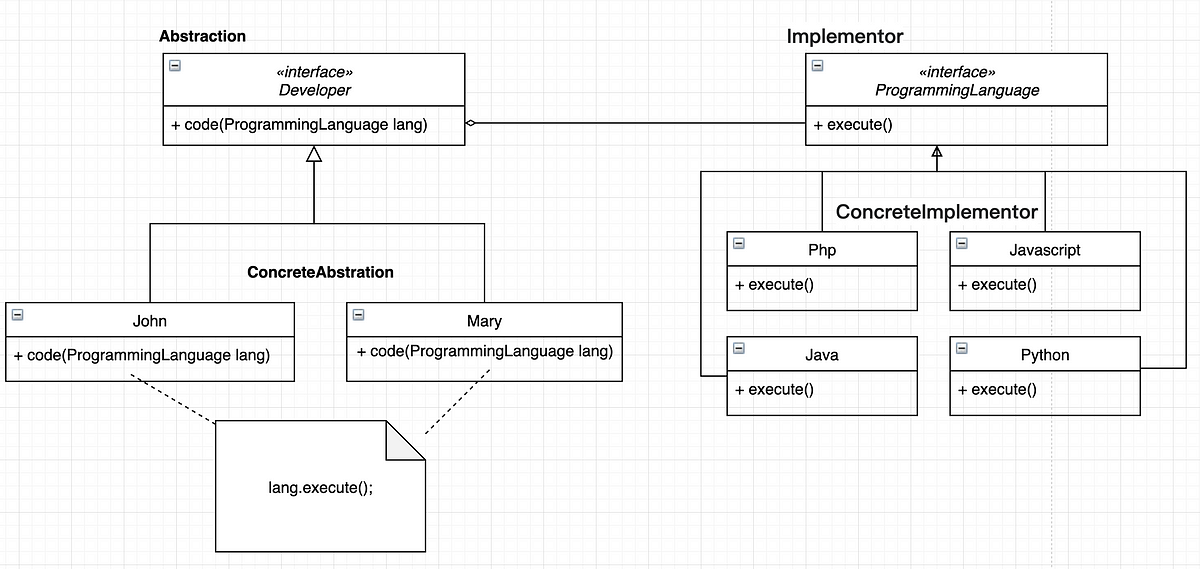
我們可能會遇到因爲物件有不同的變型,而造成組成出來的類別衆多的困擾,例如汽車與機車,都分別有藍色與白色,就有四種排列組合:藍色汽車、白色汽車、藍色機車、白色機車,隨著交通工具的總類與顏色變多,可以組合出來的數量就會爆炸性地增加。如果你也有這個困擾,那就一起來看看如何使用 Bridge 設計模式來解決吧!
HIHI~😍 如果你是第一次來的話,『Chan-Chan-Dev』是一個專門用簡單的圖文與故事講解網路程式技術的網站。
若你也喜歡用這種方式學習的話,歡迎加入 Chan-Chan-Dev Facebook 的粉絲團,在發佈的時候就有比較多機會收到通知喔!😍
設計模式有很多種,但自己都是處於一知半解,所以在學習的過程也做些筆記與思考,希望幫助自己更能理解用法與使用的時機。
而這次在 Refactor Guru 的學習了 Bridge 的這個設計模式,但以下是我自己掰出來的小情境與筆記,所以我們來看看 Bridge 的設計模式要怎麼使用囉。
不用 Bridge 的設計模式會怎樣?🤔
一樣來個情境做起手式,傑西 KeyCode 有限公司的工程師有 John、Mary,他們兩位都會寫 JAVA、PHP、Javascript、Python 的這幾種程式語言。
如果把他們的寫全部的語言全部都列出來,那會得到以下的這幾種 class。

必須要把每一種排列組合列出來
1 | public interface Developer{ |
1 | // John ------------------------ |
1 | class JohnPhp implements Developer { |
1 | class JohnJavascript implements Developer { |
1 | class JohnPython implements Developer { |
1 | // Mary ------------------------------------ |
1 | class MaryPhp implements Developer { |
1 | class MaryJavascript implements Developer { |
1 | class MaryPython implements Developer { |
Client 使用
1 | public static void main(String[] args){ |
如果今天公司需要工程師在多會一種語言 Go,那就需要在新增幾個 class:
- JohnGo
- MaryGo
如果今天新加入了一位工程師 Ken,那就會在需要新增幾個 class:
- KenJava
- KenPhp
- KenJavascript
- KenPython
- KenGo
再繼續多幾個新的工程師與新的語言就會得到以下的畫面:

Bridge 的使用時機
適合類似上述情況的多種狀況的排列組合,隨著新增一種組合,總共的組合數量就會成指數型成長的 class 狀態,這時候就很適合將不同的『類別』拆分出來,以上面的狀況來說可以拆分成 Developer 與 ProgrammingLanguage 兩種類別,並且讓 Developer 依賴 ProgrammingLanguage 的界面。

經過類別整理後的拆分結果
1 | // ProgrammingLanguage ---------- |
1 | class Java implements ProgrammingLanguage{ |
1 | class Php implements ProgrammingLanguage{ |
1 | class Javascript implements ProgrammingLanguage{ |
1 | class Python implements ProgrammingLanguage{ |
1 | // Developer ------------------------ |
1 | class John implements Developer { |
1 | class Mary implements Developer { |
有了上面針對類別拆分後,我們可以調整我們的程式碼 😇:
Client 使用
1 | public static void main(String[] args){ |
所以如果新增一個語言 Go 的話
1 | class Go implements ProgrammingLanguage{ |
所以如果新增一位工程師 Ken 的話
1 | class Ken implements Developer { |
所以我們就可以:
1 | public static void main(String args[]){ |
所以設計模式 Bridge 到底是什麼?😳
從 wiki 上的定義來看:
橋接模式是軟體設計模式中最複雜的模式之一,它把事物對象和其具體行爲、具體特徵分離開來,使它們可以各自獨立的變化。事物對象僅是一個抽象的概念。如「圓形」、「三角形」歸於抽象的「形狀」之下,而「畫圓」、「畫三角」歸於實現行爲的「畫圖」類之下,然後由「形狀」調用「畫圖」。
結構上會有以下幾種角色:
Abstraction
- 定義抽象的接口該接口包含實現具體行爲
Refined Abstraction
- 抽象接口 Abstraction 的子類,依舊是一個抽象的事物名
Implementor
- 定義具體行爲、具體特徵的應用接口
ConcreteImplementor
- 實現 Implementor 接口
如果用 UML 圖來表示傑西 KeyCode 有限公司的例子的話大概會長得像這樣子:
UML

經過調整之後的寫法是不是更有結構性?也在新增任何的元素更爲簡單容易了呢? 😇
如果資訊有誤也很歡迎在下方留言,我也是還在學習的路上,最後感謝收看囉。 😆